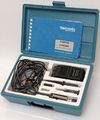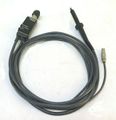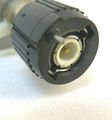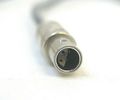P6202: Difference between revisions
No edit summary |
No edit summary |
||
| Line 27: | Line 27: | ||
{{Spec | Cable length | 2 m (6.5') }} | {{Spec | Cable length | 2 m (6.5') }} | ||
{{EndSpecs}} | {{EndSpecs}} | ||
==Links== | |||
* [[Media:Tekscope 1976 V8 N2.pdf | Tekscope Vol. 8 No. 2, 1976, p.16+]]: [[Ron Lang]], ''A new low-cost 500 MHz probe '' | |||
==Internals== | ==Internals== | ||
Revision as of 16:01, 27 February 2022
The Tektronix P6202 is a 500 MHz active 10× FET probe with 50 Ω output impedance, introduced in 1976.
The 6202 has its own mains power supply, the 6202A (1980) has a LEMO S-series connector fitting the 7000-series scopes' probe power outlets.
Key Specifications
| Bandwidth | DC to 500 MHz (16 Hz lower limit with additional AC coupling tip) |
|---|---|
| Rise time | < 0.7 ns |
| Attenuation | 10 : 1 (100 : 1 with additional 10× attenuator tip, 010-0384-00) |
| Input impedance | 10 MΩ // 2 pF with or without additional 10× attenuator tip, +2 pF for AC coupling tip |
| Input range | ± 6 V (± 60 V with additional 10× attenuator tip) |
| DC offset | ± 55 V (± 200 V with additional 10× attenuator tip) |
| Max input | ± 200 V (nondestructive) |
| Cable length | 2 m (6.5') |
Links
- Tekscope Vol. 8 No. 2, 1976, p.16+: Ron Lang, A new low-cost 500 MHz probe
Internals
An initial 8 MΩ : 2 MΩ divider drives a dual JFET (source follower + current source), a PNP emitter follower and finally an NPN emitter follower as a cable driver. These stages use SMD components located in the probe tip. The probe control box at the end of the coax only contains a ±7 V regulator, a switchable 50 Ω terminator, and the offset potentiometers that supply ±15 V to the bottom of the input divider. There is no input protection apart from the divider.
Pictures
P6202
-
Carrying case
-
Probe in case, with power supply, 10:1 pre-divider tip (010-0384-00), hook tip, AC coupling tip and connection box.
-
Amplifier in probe tip (SMD components in 1976!)
-
Amplifier in probe tip, reverse
-
Connection box
-
-
-
P6202A
-
-
-
-
-
-
Probe power connector
-
Case exterior
-
Schematic
Measurements
Rise time of a P6202 500 MHz FET probe measured on a 7S12 plugin in a 7844 mainframe (with 25 ps S-52 pulse generator head and 25 ps S-4 sampling head). Measured rise time ~440 ps observed on this specimen is equivalent to 795 MHz bandwidth.
-
at 1 ns/Div
-
at 100 ps/Div

















